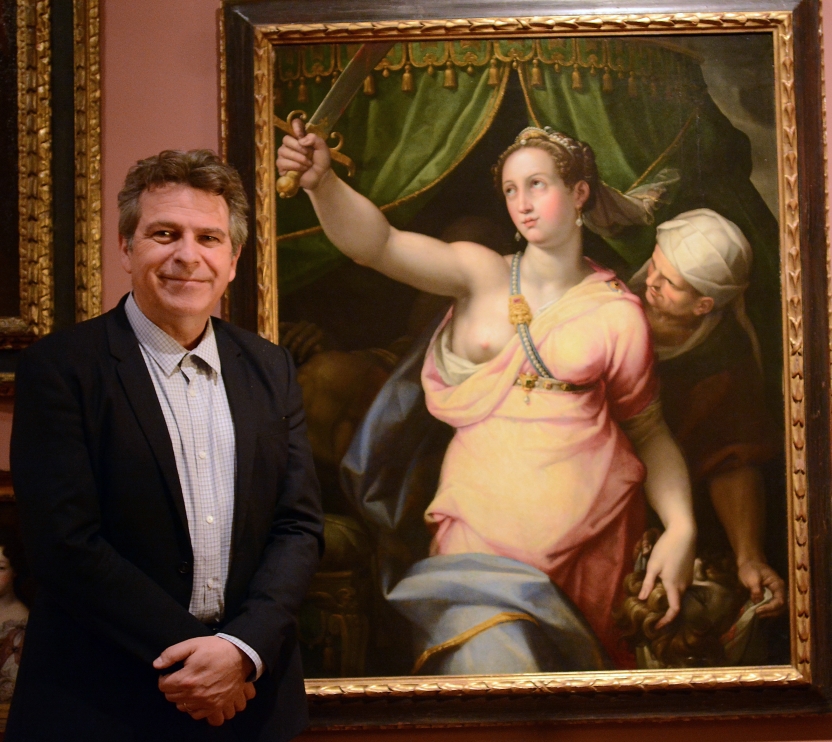Middlebury Scholar Unravels an Art-Historical Detective Story

MIDDLEBURY, Vt. — Hanging in the Middlebury College Museum of Art, Judith with the Head of Holofernes depicts a story popular among Renaissance painters: The young widow of Judea enters the tent of an invading Assyrian general bent on conquering and destroying her home. She wins his trust, he admires her beauty, and she, in time, takes his head.
There’s another story lurking behind the lush 16th-century oil painting at the museum — one that deals not with mythology, but with the mysteries of art, acquisition, and attribution. Decades after the College acquired this painting, armed with an image on an iPad and a sense of infectious curiosity, Professor of History of Art and Architecture and Director of the Arts Pieter Broucke set out to unravel that tale.
That story — an “art-historical detective” tale — was the topic of Broucke’s April 29 lecture, the last in this year’s series of “Off the Wall” informal discussions on art. Broucke, noted the museum’s chief curator Emmie Donadio in her introduction, is “unstoppable when he has a goal in mind.”
Broucke’s goal: to find out the true origins of the painting Middlebury College acquired in 1968 from a Park Avenue dealer. At the time, the painting came with a straightforward attribution to Hans von Aachen (1552-1615) a German Mannerist painter.
And yet, as the years passed, scholars began to doubt that attribution. “It just didn’t work,” said Broucke. Teaching the painting in an introductory art history class, Broucke and his students began discussing some of the anomalies. Why was it that a painting supposedly crafted by a German Mannerist recalled elements popularized by Michelangelo? The color scheme recalled not Northern Europe, but rather the High Renaissance, and stylistic details just didn’t add up.
Broucke is quick to point out he does not specialize in Renaissance art. But he does travel widely. And so Broucke uploaded a picture of the painting to his iPad, and began asking questions of the experts he encountered in his travels. A consensus emerged: the painting was almost certainly not Northern European, but rather Northern Italian. Look in Parma, Bologna, Milan, he heard.
He found himself closer still when, in 2014, he spotted a painting at auction at Christie’s in New York that, while clearly not by the same maker of Middlebury’s Judith, recalled the same mood. He soon began investigating the School of Bologna, both a movement and a school founded by the Carracci brothers in 1582. Broucke began checking and crosschecking Middlebury’s Judith against the works of painters closely — and even remotely — associated with the school.
Nothing clicked.
“I felt I was close, but I just couldn’t bring the project home,” said Broucke.
That’s when, last year, Broucke ran into the noted Italian art dealer Fabrizio Moretti. Broucke whipped out his iPad, showed Moretti Middlebury’s painting, and received this clue in return: “Samacchini,” Moretti told him. “You have to look at Samacchini.”
Broucke jotted down the name phonetically; he didn’t know the artist. Samacchini was, it turned out, Orazio Samacchini (1532-1577), an Italian painter active in Rome (where he overlapped with Michelangelo), Parma, and his native city — Bologna. Suddenly the clues began to fall into place.
Broucke then applied what’s known as the Morellian Method, a process of systematic “diagnosis” that looks at the small, easily overlooked details of paintings to make or confirm attributions. In Samacchini’s work, painting after painting, Broucke found remarkably similar details to ones in Middlebury’s Judith. The painting likely dates to the early 1570s — the period just before Samacchini’s untimely death.
“We’ve traced a story that started in Middlebury and then took me and [director of the college’s art museum] Richard Saunders to New York, Belgium, Holland, Bologna,” said Broucke; the tale took them back to the works of 16th-century Italian painters and into the modern world of art dealers, auction houses, arts fairs, museum professionals and scholars — and served as a reminder that a piece of art, even one that is centuries old, is still ripe for new research and understanding.
“Museums are not repositories of objects,” said Broucke. “They’re really also active laboratories for conducting research.”
By Kathryn Flagg ’08; Photo by Robert Keren

